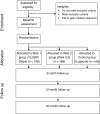WALK 2.0 - using Web 2.0 applications to promote health-related physical activity: a randomised controlled trial protocol
- PMID: 23642010
- PMCID: PMC3653819
- DOI: 10.1186/1471-2458-13-436
WALK 2.0 - using Web 2.0 applications to promote health-related physical activity: a randomised controlled trial protocol
Abstract
Background: Physical inactivity is one of the leading modifiable causes of death and disease in Australia. National surveys indicate less than half of the Australian adult population are sufficiently active to obtain health benefits. The Internet is a potentially important medium for successfully communicating health messages to the general population and enabling individual behaviour change. Internet-based interventions have proven efficacy; however, intervention studies describing website usage objectively have reported a strong decline in usage, and high attrition rate, over the course of the interventions. Web 2.0 applications give users control over web content generated and present innovative possibilities to improve user engagement. There is, however, a need to assess the effectiveness of these applications in the general population. The Walk 2.0 project is a 3-arm randomised controlled trial investigating the effects of "next generation" web-based applications on engagement, retention, and subsequent physical activity behaviour change.
Methods/design: 504 individuals will be recruited from two sites in Australia, randomly allocated to one of two web-based interventions (Web 1.0 or Web 2.0) or a control group, and provided with a pedometer to monitor physical activity. The Web 1.0 intervention will provide participants with access to an existing physical activity website with limited interactivity. The Web 2.0 intervention will provide access to a website featuring Web 2.0 content, including social networking, blogs, and virtual walking groups. Control participants will receive a logbook to record their steps. All groups will receive similar educational material on setting goals and increasing physical activity. The primary outcomes are objectively measured physical activity and website engagement and retention. Other outcomes measured include quality of life, psychosocial correlates, and anthropometric measurements. Outcomes will be measured at baseline, 3, 12 and 18 months.
Discussion: The findings of this study will provide increased understanding of the benefit of new web-based technologies and applications in engaging and retaining participants on web-based intervention sites, with the aim of improved health behaviour change outcomes.
Trial registration: Australian New Zealand Clinical Trials Registry, ACTRN12611000157976.
Similar articles
-
Using Web 2.0 applications to promote health-related physical activity: findings from the WALK 2.0 randomised controlled trial.Br J Sports Med. 2017 Oct;51(19):1433-1440. doi: 10.1136/bjsports-2016-096890. Epub 2017 Jan 3. Br J Sports Med. 2017. PMID: 28049624 Free PMC article. Clinical Trial.
-
Rural Environments and Community Health (REACH): a randomised controlled trial protocol for an online walking intervention in rural adults.BMC Public Health. 2014 Sep 18;14:969. doi: 10.1186/1471-2458-14-969. BMC Public Health. 2014. PMID: 25236776 Free PMC article. Clinical Trial.
-
TaylorActive--Examining the effectiveness of web-based personally-tailored videos to increase physical activity: a randomised controlled trial protocol.BMC Public Health. 2015 Oct 5;15:1020. doi: 10.1186/s12889-015-2363-4. BMC Public Health. 2015. PMID: 26438225 Free PMC article. Clinical Trial.
-
Interventions for promoting physical activity in people with neuromuscular disease.Cochrane Database Syst Rev. 2021 May 24;5(5):CD013544. doi: 10.1002/14651858.CD013544.pub2. Cochrane Database Syst Rev. 2021. PMID: 34027632 Free PMC article.
-
Behavioural modification interventions for medically unexplained symptoms in primary care: systematic reviews and economic evaluation.Health Technol Assess. 2020 Sep;24(46):1-490. doi: 10.3310/hta24460. Health Technol Assess. 2020. PMID: 32975190 Free PMC article.
Cited by
-
Behavioural interventions delivered through interactive social media for health behaviour change, health outcomes, and health equity in the adult population.Cochrane Database Syst Rev. 2021 May 31;5(5):CD012932. doi: 10.1002/14651858.CD012932.pub2. Cochrane Database Syst Rev. 2021. PMID: 34057201 Free PMC article.
-
What is the impact of obtaining medical clearance to participate in a randomised controlled trial examining a physical activity intervention on the socio-demographic and risk factor profiles of included participants?Trials. 2016 Dec 7;17(1):580. doi: 10.1186/s13063-016-1715-4. Trials. 2016. PMID: 27927226 Free PMC article. Clinical Trial.
-
Examining the use of evidence-based and social media supported tools in freely accessible physical activity intervention websites.Int J Behav Nutr Phys Act. 2014 Aug 17;11:105. doi: 10.1186/s12966-014-0105-0. Int J Behav Nutr Phys Act. 2014. PMID: 25128330 Free PMC article.
-
Effectiveness of a web- and mobile phone-based intervention to promote physical activity and healthy eating in middle-aged males: randomized controlled trial of the ManUp study.J Med Internet Res. 2014 Jun 12;16(6):e136. doi: 10.2196/jmir.3107. J Med Internet Res. 2014. PMID: 24927299 Free PMC article. Clinical Trial.
-
Digital Health Promotion and Prevention in Settings: Scoping Review.J Med Internet Res. 2022 Jan 28;24(1):e21063. doi: 10.2196/21063. J Med Internet Res. 2022. PMID: 35089140 Free PMC article.
References
-
- US Department of Health and Human Services. Physical activity guidelines for Americans: be active, healthy and happy. Washington DC: HHS; 2008.
-
- Australian Institute of Health and Welfare. Australia’s health 2012. Canberra: AIHW; 2012.
-
- Stephenson J, Bauman A, Armstrong T, Smith B, Bellew B. The costs of illness attributable to physical inactivity in Australia: a preliminary study. Canberra: The Commonwealth Department of Health and Aged Care and the Australian Sports Commission; 2000.
Publication types
MeSH terms
LinkOut - more resources
Full Text Sources
Other Literature Sources
Medical


